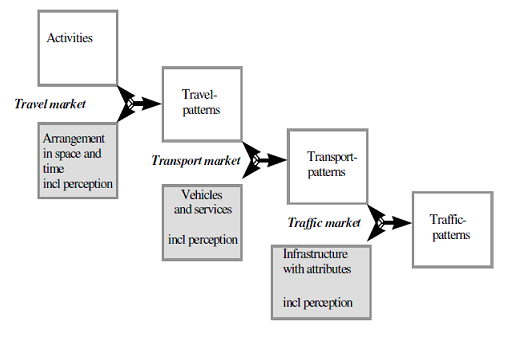Transportation system
A transportation system can be defined as the assemblage of components associated with a specific means of transport[1].
=Regional Transportation system=A regional transportation system can be defined as the combination of vehicles, infrastructure, and operations that enable the movements or “satisfy the travel demand†of people and goods within a defined region[2].
=Urban Transportation system=An urban transportation system can be defined as the set of transport infrastructures and modes that support urban movements of passengers and freight. It generally expresses the level of accessibility[3].
Contents
Policy areas in the transportation system
The transportation system can be described as a market: a system with dynamic interaction between demand and supply[4]. In this interaction, implicit and explicit choices are made on both the demand and supply sides. These choices interact.
Within the overall traffic and transport market, three market segments can be distinguished, each of which has its own supply and demand side: a trip market, a transport market, and a traffic market. The three markets and their relationships are depicted graphically below:

Figure : System diagram for the policy domain transport and traffic (Source: TNO rapport; Immers, B., Transportation System Analysis)
== Trip Market ==In the trip market, the demand side consists of activities to be performed, whose location and time are as yet unknown. The supply side consists of the spatial and temporal distribution of locations where the activities could be performed and the trips associated with them. This market is synonym with the Land Use Transport System. The output of this market consists of a set of trip patterns: an allocation of the activities to location and times.
Transport Market
The trip patterns (the output of the Trip Market) become the demand side of the transport market: the demand for vehicles for Passenger Transport and Freight Transport and Logistics. The supply side of the transport market consists of the available supply of vehicles and services to accommodate these trips (specified according to place and (time) and how they are perceived. The output of this market consists of a set of realized transport patterns: an allocation of trips to the different Modes of Transport and Transport Services.
Traffic Market
The transport patterns (the output of the Transport Market) become the demand side of the traffic market: the demand for infrastructure to accommodate the vehicles and services. The supply side of the traffic market consists of the available infrastructure with all its attributes, such as Modes of Transport, Traffic Control Systems (Traffic Management Center), Roads, Rails, Terminals, Traffic Intersections, Canals, Bridges, Bicycle / Pedestrian Facilities. The output of the traffic market consists of a set of realized travel patterns: an allocation of teransport vehicles and services to the infrastructure.
Operations
Operations deal with the way the vehicles are operated, and the procedures set for this purpose including financing, legalities and policies. In the transport industry, operations and ownership of infrastructure can be either public or private, depending on the country and mode[5].
Usually, operations of transportation systems to perform [#_Traffic_management_1 traffic management] is done in traffic management centres.
Footnotes and references
- ↑ from: Transportation security and the role of resilience - A foundation for operational metrics.pdf / Tolley andTurton,1995,p.42
- ↑ from: Transportation security and the role of resilience - A foundation for operational metrics.pdf / Cascetta, 2001,p.xv; see also Tolley and Turton,1995,p.13; Black, 2003, p.3
- ↑ from: http://people.hofstra.edu/geotrans/eng/ch6en/conc6en/ch6c2en.html
- ↑ from: RAND Europe - Systeemdiagram voor het beleidsveld vervoer en verkeer.pdf
- ↑ http://en.wikipedia.org/wiki/Transport